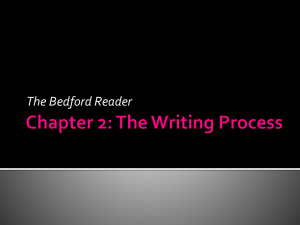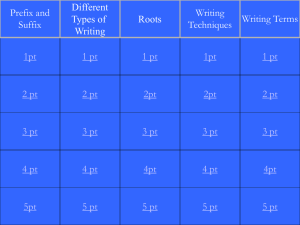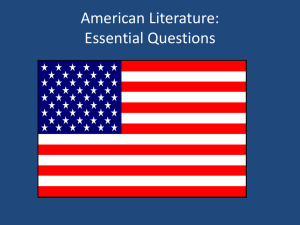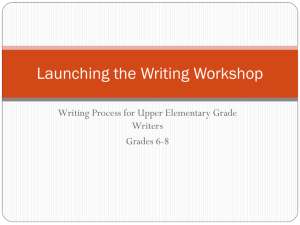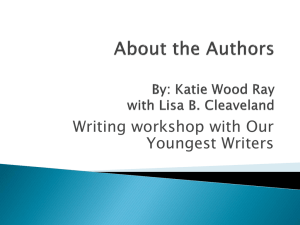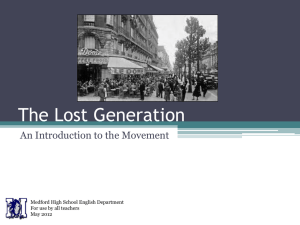A Curricular Plan for the Writing Workshop By Lucy Calkins and
advertisement
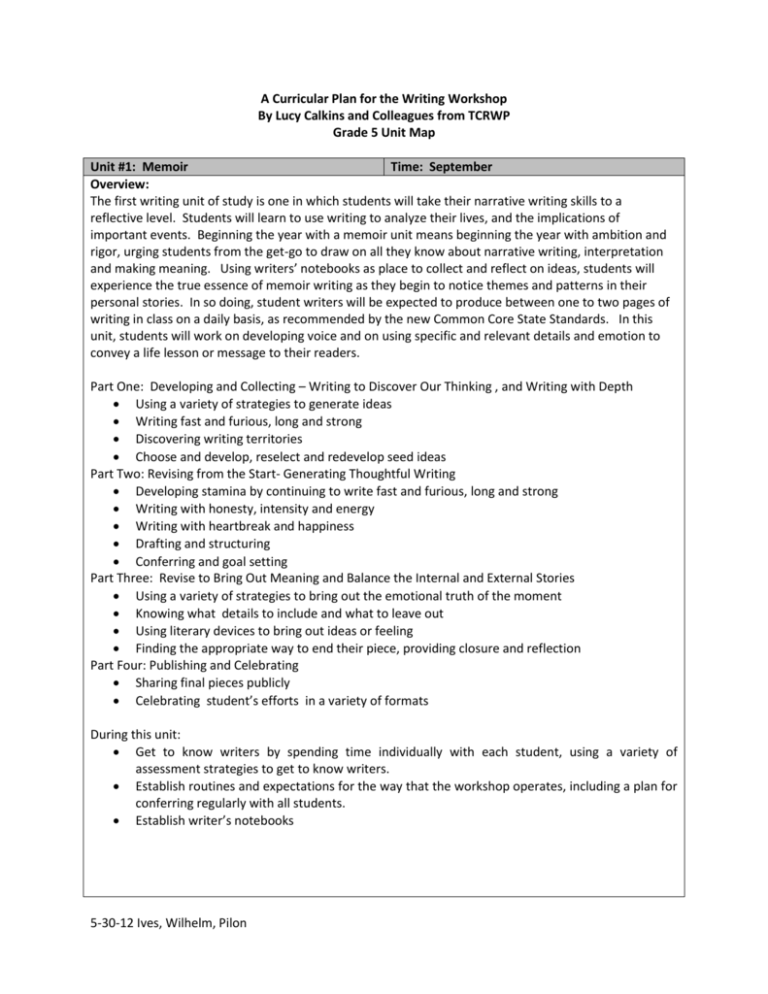
A Curricular Plan for the Writing Workshop By Lucy Calkins and Colleagues from TCRWP Grade 5 Unit Map Unit #1: Memoir Time: September Overview: The first writing unit of study is one in which students will take their narrative writing skills to a reflective level. Students will learn to use writing to analyze their lives, and the implications of important events. Beginning the year with a memoir unit means beginning the year with ambition and rigor, urging students from the get-go to draw on all they know about narrative writing, interpretation and making meaning. Using writers’ notebooks as place to collect and reflect on ideas, students will experience the true essence of memoir writing as they begin to notice themes and patterns in their personal stories. In so doing, student writers will be expected to produce between one to two pages of writing in class on a daily basis, as recommended by the new Common Core State Standards. In this unit, students will work on developing voice and on using specific and relevant details and emotion to convey a life lesson or message to their readers. Part One: Developing and Collecting – Writing to Discover Our Thinking , and Writing with Depth Using a variety of strategies to generate ideas Writing fast and furious, long and strong Discovering writing territories Choose and develop, reselect and redevelop seed ideas Part Two: Revising from the Start- Generating Thoughtful Writing Developing stamina by continuing to write fast and furious, long and strong Writing with honesty, intensity and energy Writing with heartbreak and happiness Drafting and structuring Conferring and goal setting Part Three: Revise to Bring Out Meaning and Balance the Internal and External Stories Using a variety of strategies to bring out the emotional truth of the moment Knowing what details to include and what to leave out Using literary devices to bring out ideas or feeling Finding the appropriate way to end their piece, providing closure and reflection Part Four: Publishing and Celebrating Sharing final pieces publicly Celebrating student’s efforts in a variety of formats During this unit: Get to know writers by spending time individually with each student, using a variety of assessment strategies to get to know writers. Establish routines and expectations for the way that the workshop operates, including a plan for conferring regularly with all students. Establish writer’s notebooks 5-30-12 Ives, Wilhelm, Pilon Stage 1 – Common Core State Standards and Indicators– What must students know and be able to do? Writing: Text Types and Purposes 5.TTP.03 Write narratives to develop real or imagined experiences or events using effective technique, descriptive details, and clear event sequences. a) Orient the reader by establishing a situation and introducing a narrator and/or characters; organize an event sequence that unfolds naturally. b) Use narrative techniques, such as dialogue, description, and pacing, to develop experience and events or show the responses of characters to situations. c) Use a variety of transitional words, phrases, and clauses to manage the sequence of events. d) Use concrete words and phrases and sensory details to convey experiences and events precisely. e) Provide a conclusion that follows from the narrated experiences or events. Production and Distribution of Writing 5.PDW.04 Produce clear and coherent writing in which the development and organization are appropriate to task, purpose, and audience. 5.PDW.05 With guidance and support form peers and adults, develop and strengthen writing as needed by planning, revising, editing, rewriting, or trying a new approach. Range of Writing 5.RW.10 Write routinely over extended time frames (time for research, reflection, and revision) and shorter time frames (a single sitting or a day or two) for a range of discipline-specific tasks, purposes, and audiences. Essential Questions for Students Guiding Questions for Teachers How do I use my life as a source of ideas for How can I help my students discover their own writing memoir writing? territories? How can I write a structured memoir that uses How can I share mentor texts with my students that voice and emotion to convey meaning to my will enable them to write effective memoirs? reader? How can I share the importance and effectiveness of using personal voice and emotion to make writing more interesting? How can I use the writing process effectively to make my memoir writing stronger? How can I teach writers to use correct conventions to convey their meaning? How can I teach writers to edit, publish and celebrate their writing? 5-30-12 Ives, Wilhelm, Pilon Stage 2– Common Assessment – What is the evidence of understanding? Universal Screens Formative Assessment Strategies Fall Writing on Demand Assessment Writer’s Notebooks Individual Writing Conferences Stage 3 – Instruction – What learning experiences will lead to understanding? Skills: Key Terms/Vocabulary generate ideas perspective turning point freewrite theme life topic storytelling external events summarizing internal feelings memoir reflective writing entry message convey metaphor One Possible Sequence of Teaching Points (A Note To Teachers: Please remember that this one possible sequence of teaching points. Based on the students in your class, you may decide to spend more time on some things and less on others. This is a guide to help you make decisions based on the learners in front of you.) Part One: Developing and Collecting – Writing to Discover Our Thinking, and Writing with Depth “Today I want to teach you that writers often begin by writing lots and lots of Small Moment stories—small moments that capture the tensions in the writer’s life, that show turning points and life-themes. Today we are going to collect snippets of as many memories as you can squeeze out, and write!” x Mid-workshop teaching point: “When writers are stuck for ideas, we rely on what we already know. One way to do this is by listing the strategies we’ve learned for collecting small moments (first times, last times, important people, places, things), quickly in our notebooks, and using one of them to quickly develop new topics to write about.” “Today I want to remind you to draw on everything you already know about good writing to better your entries. Writers need to ask ourselves if we are using action, incorporating dialogue, using descriptive details, and storytelling rather than summarizing.” “Today I’m going to teach you that memoirists look for Life Topics by rereading their writer’s notebooks or recent entries, looking for subjects that thread their way through much of what they have written. Uncovering Life Topics (Session I, Memoir: The Art of Writing Well).” x Tip: “Writers reread old entries, asking themselves, ‘What is it I’m seeing again and again in my writing?’ They’re on the lookout for people, places, emotions, or objects that repeat themselves.” x Mid-workshop teaching point: “Sometimes Life Topics are hidden, and writers need to dig deeper to discover them. As writers, we can look at seemingly unconnected entries and ask, ‘How might these connect with each other?’ Often, there are underlying issues or truths beneath the seemingly separate bits.” x Tip: “Sometimes a writer finds he or she has one or two great images—within which the writer’s heart opens. We search for those images.” x Share: “Writers take charge of their own writing lives by creating self-assignments.” “Today I want to teach you that writers remember the wise words of poet Richard Price, ‘The 5-30-12 Ives, Wilhelm, Pilon bigger the meaning, the smaller you write.’ They take the big meanings they uncover and imagine the ways they might write small about them, often by collecting Small Moment stories that go with a Life Topic, attempting to bring out the deeper meaning as they write the story. As they do this, they rely on everything they know about generating small moment ideas. They might think of first times, last times, turning points, or moments when we learned something, but this time using those strategies to generate ideas that relate to a Life Topic.” x Mid-workshop teaching point: “Writers use what they know, the strategies they have in their back pocket, to generate and write small moments. They do the same when writing about big meanings. Yesterday you learned to reread your entries looking for hidden themes that underlie several stories. Another way to write about big ideas is by taking that idea and writing, ‘The thought I have about this is . . .’ and then writing long to uncover new thoughts.” “Writers don’t just write to come up with new story ideas; they write to find depth in the ideas they’ve already uncovered. One way to do this is by writing, as a famous memoirist once said, ‘Write what you don’t know about what you know.’ To do this, writers take a topic they know well and ask, ‘What don’t I know about what I know?’ and ‘Where’s the mystery in this topic?’ and then write to explore those questions.” x Mid-workshop teaching point: “Writers write to explore new ideas and do so by asking and entertaining hard questions and by visiting a subject, repeatedly, from different perspectives. After a writer has written about a subject by advancing one idea or claim on that subject, the writer may deliberately try to write about the same subject, advancing the exact opposite idea.” x Share: “Sometimes a writer thinks about a topic or a question by linking that one starting subject to one thing, another, another” (to a quote, a statistic, a memory, a classmate’s idea). “Today I want to teach you that when a writer wants to take a deep dive in his or her writing, one strategy that we use is to read (or listen) to literature and then write. We let the story wash over us, and then in the silence afterwards, we write what we need to write. We don’t write about the text; we write in the direction the text has pushed us.” x Mid-workshop teaching point: “Writers make use of multiple strategies as they write, combining and layering what they’ve learned. Even as they freewrite off a piece of literature, a writer might choose to then take that writing and ask, ‘What’s the mystery here?’ or decide to write small about a time in their life when this big idea was especially true. All of this is just to say that writers make use of everything they know, employing strategies on more than one day and for more than one purpose.” x Share: “Writers can rely on partners to help them make plans for future work.” “Today I’m going to teach you that writers need lots of ways to accomplish almost any job. Writers have lots of strategies for choosing a seed idea, and we know that sometimes the process of focusing our writing, choosing a seed idea, happens over the course of many days. Strategies for choosing a seed idea include: rereading entries with intention and value, marking small parts of writing that stand out, looking for connections and patterns, categorizing our most powerful writing into several possible Life Topics, choosing one Life Topic, and writing an entry that combines various images and ideas related to our topic.” x Mid-workshop teaching point: “After choosing a blob idea, writers take time to capture this idea in a paragraph or two.” x Share: “Writers know that probing questions help writing to evolve more quickly. They take a reflective stance on their own ideas by asking questions like, ‘What are the reasons I keep writing about this?’ or ‘I’ve written what’s obvious about this, so what else can I write?’ or ‘What do I want to show about myself?’ and ‘What does this say about me?’’’ 5-30-12 Ives, Wilhelm, Pilon Part Two: Drafting and Structuring Go Hand in Hand “Writers structure texts in lots of different ways, and today I’m going to teach you a strategy for doing this. One way we learn to structure our texts is by reading texts other authors have written and by studying the structures they have used or made. We can then decide which structure feels best suited to our topic and make a writing plan for ourselves.” x Mid-workshop teaching point: “Writers often need to make decisions as they study mentor texts, deciding whether they are memoirs or personal narratives, and then making a decision about what structure the text seems to follow.” x Share: “Writers take time to reread their own writing from an aerial view, noticing how they’ve structured their entries.” “Today I am going to teach you how to be your own teacher! When a writer can’t go to a writing teacher, we can become our own. But before we can suggest next steps for ourselves, we need to spend time listening. A good writing teacher looks backwards in order to look forward. He or she might ask questions about previous work and how it turned out, why a writer is trying certain things, what else he or she plans to try, and what plans the writer has for what he or she will do next.” x Mid-workshop teaching point: “As writers elaborate on their seed idea and collect small moments to go along with it, they often find they want to revise what they are saying. Rewriting and revising a seed idea, imagining new possibilities, is an important part of the writing process.” x Share: “Writers share among themselves and help each other to care about their blob ideas by discussing the ways they’re finding to invest themselves in their topic.” “Today I want to teach you that before writers begin their first drafts outside of their notebooks, they think hard about how they can inspire themselves to do their best work. Writing well requires talent and knowledge and skill, yes—but also magic. One way to find our own inspiration is by learning from other authors about what they do and then making our own plan from what we learned.” x Mid-workshop teaching point: “Writers find the courage to write about the real topics that are on their minds. When we find ourselves writing entries where everything is perfect, we can ask, ‘Where’s the struggle in this subject?’ and ‘Is this the truth of what has been on my mind lately?’” x Share: “When writers find they have an excess of entries, they pause to ask, ‘What do I really want to say?’ and then use that question to narrow their writing and find a new focus.” “Writers, today I want to let you in on a secret that memoirists know, that both the external events and the internal feelings of a story need to evolve across a timeline, a story mountain. When writers write a story they know there will be a sequence of actions—that one thing will happen, then another thing will happen, and another. Not only this, but there also needs to be parallel sequences of re-actions, of feelings and thoughts and dreams and fears that the main character (in memoir, that will be you) experiences. With each external event, the narrator or the main character sees and thinks and feels a bit differently on the inside. Something happens, and we realize something we hadn’t realized before. Something else happens, and we feel something we hadn’t felt before.” x Mid-workshop teaching point: “When writers tell the internal part of their story, they find that one way to do this is by adding internal thinking. But this isn’t the only way! We can also reveal the internal story with specific actions that show how a character is feeling.” x Share: “When trying to put feelings on a page, novice writers will often try to find one perfect word to describe the emotion. What more experienced writers know is that usually when we want to reveal a feeling, we need to do so by writing sentences or even paragraphs that capture 5-30-12 Ives, Wilhelm, Pilon the emotion. We can do this by helping people know the specific way the writer experienced that emotion.” “Writers know that details in a memoir can say something about the kind of person we are, the kind of life we lead. Today I’m going to teach you how writers, as they work to reveal themselves through memoir, remember they can show themselves not only by bringing out their internal thoughts but also by spotlighting details that reveal whatever it is they want to say about themselves.” x Mid-workshop teaching point: “Writers sometimes need to invent details, making sure they are ones that reveal the truth of their lives.” x Share: “Writers know that tiny moments, even something as small as a hug, can be stretched into a sequence of external events, a journey of changing feelings.” “Today I want to teach you that just like whole pieces of writing often have a structure—with narrative writing often organized chronologically by time, and essay writing often organized into big ideas and then supportive details— so, too, a single paragraph or a single chunk of a text often will also have a structure. After a writer generates what amounts to a pile of ideas, the writer rereads all of these and figures out how he or she will structure the chunk of text, relying on what she or he learned from studying mentor texts to help make this decision.” x Mid-workshop teaching point: “When writers are looking to lift the level of their own writing, they study what other writers have done. They think, ‘What do I like that this writer has done?’ and ‘How could I use a similar technique in my writing?’’’ x Share: “Writers often alternate between narrative and reflective writing when working on a piece. They write a bit of their narrative and then stop to write reflectively about it, exploring new ideas and finding big meanings they’ve yet to bring forth in their narrative. Writers then return to their narrative to revise and rework it, bringing out what they discovered while reflecting.” Part Three: Revise to Bring Out Meaning and to Balance the Internal and External Story “Writers know that the hard work they do changes as they work through the writing process. Today I want to teach you about a special sort of reading writers do when they read their own writing. They do not skim over it as if they’ve seen the draft a hundred times. Instead, they examine the draft in all its particulars, allowing the page to teach them how to write.” x Mid-workshop teaching point: “Writing well takes attentiveness, and this is something writers know well. It takes getting to hard parts and pushing past them, instead of using the hard parts as an invitation to wander around hoping someone is going to deliver a magic solution.” x Share: “Writers read our own drafts noting the component sections, asking, ‘How is this draft almost-but-not-quite structured?’ Then we make revisions to bring forth and complete the structures.” “Today I want to teach you how writers often take a tiny detail from our lives— often something that could be very ordinary—and let that one detail represent the whole big message of our story or our memoir.” x Mid-workshop teaching point: “As writers, you’ve focused intently on crafting powerful lines as you write—lines that hold meaning that is enormous to your writing. Writers often search their writing for lines such as these looking for ways to highlight them, because highlighting a particularly strong line can also highlight a particularly strong idea. One way to make a powerful line stand out is by repeating it here and there across a piece of writing.” x Share: “When writers use a metaphor at the end of our piece, we first ask, ‘What message do I want to convey as this story ends?’ and then use the metaphor to bring forth that meaning.” 5-30-12 Ives, Wilhelm, Pilon Part Four: Editing, Publishing, and Celebrating “Today I want to teach you that when writers edit our writing, we read it out loud to hear the sound of each word, to hear the rhythm of our sentences. Truman Capote wrote, ‘To me, the greatest pleasure of writing is the inner music the words make.’ The sound of our words is powerful. Writers communicate with readers by choosing words that convey not only the content but also the mood, the tone, and the feelings that we want to convey.” x Mid-workshop teaching point: “Writers can play with punctuation as we write to bring out the tone in our writing, making our writing sound as we intended it to.” x Share: “Writers rely on partners to help them edit, putting one piece between the two of them and reading it, inch by inch, asking whether each sentence creates a clear image and moves the idea along.” Resources: Calkins, Lucy and Colleagues. 2011. A Curricular Plan for The Writing Workshop, Grade 5. Portsmouth, NH: Heinemann. Calkins, Lucy: Mentor Texts: Websites and Technology: 5-30-12 Ives, Wilhelm, Pilon


